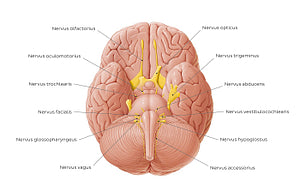Paul Kim
12 cranial nerves (Latin)
12 cranial nerves (Latin)
This illustration summarizes the anatomy of each cranial nerve. The first two cranial nerves, the n. olfactorius (CN I) and n. opticus (CN II) are the only two cranial nerves that originate from the cerebrum. More specifically, the n. olfactorius (CN I) can be generally used as an umbrella term to describe components extending from the pars olfactoria of the nasal mucosa to the cortex olfactorius (via Lamina cribosa ossis ethmoidalis). The n. opticus (CN II) extends from the retina of the eye to the cortex visualis primarius (area striata) via the canalis opticus. All other cranial nerves originate from the brainstem (truncus encephali). The n. oculomotorius (CN III) and n. trochlearis (CN IV) nerves originate from the midbrain (mesencephalon). The n. abducens (CN VI) arises from the junctio pontomedullaris. Since these three nerves act on eye muscles, they extend from the brainstem and exit via the fissura orbitalis superior. The n. trigeminus (CN V) originates from the pons and gives rise to three divisions: n. ophthalmicus (V1), n. maxillaris (V2), and n. mandibularis (V3) which exit the cranium via the fissura orbitalis superior, foramen rotundum and foramen ovale, respectively. The n. facialis (CN VII) originates from the junctio pontomedullaris by two roots: radix motoria/sensoria. The n. vestibulocochlearis (CN VIII) also originates from the junctio pontomedullaris and consists of a pars vestibularis and pars cochlearis. Both CN VII and VIII exit via the meatus acusticus internus. The n. glossopharyngeus (CN IX) originates from the superior/rostral portion of the medulla oblongata while the n. vagus (CN X) also originates from the medulla oblongata, just caudal to CN IX. The n. accessory (CN XI) has traditionally been described as having a radix spinalis and radix cranialis. As seen in the illustration, its radix cranialis emerges from the medulla oblongata, while the radix spinalis arises from the upper five or six cervical segments of the spinal cord. CN IX-XI all exit the skull via the foramen jugulare. Finally, the n. hypoglossus (CN XII) also originates from the medulla oblongata. Its dozen roots pass laterally across the fossa posterior cranii before merging into a single trunk which exits via the canalis hypoglossalus.
Regular price
$7.56 USD
Regular price
Sale price
$7.56 USD
Unit price
per
Couldn't load pickup availability


#F1CA2E
#B09656
#B48A19
#96624E
#F4D56C
#D8B0A6

